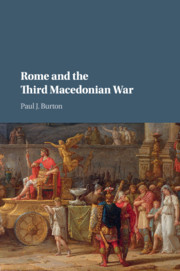Refine search
Actions for selected content:
15418 results in Military history
Conclusion
-
- Book:
- Captives of War
- Published online:
- 25 October 2017
- Print publication:
- 12 October 2017, pp 224-230
-
- Chapter
- Export citation

Rome and the Third Macedonian War
-
- Published online:
- 29 September 2017
- Print publication:
- 12 October 2017

Exhibiting War
- The Great War, Museums, and Memory in Britain, Canada, and Australia
-
- Published online:
- 29 September 2017
- Print publication:
- 21 September 2017

A History of Military Occupation from 1792 to 1914
-
- Published by:
- Edinburgh University Press
- Published online:
- 23 September 2017
- Print publication:
- 07 March 2016

In their Time of Need
- Australia's Overseas Emergency Relief Operations 1918–2006
-
- Published online:
- 21 September 2017
- Print publication:
- 04 August 2017
5 - Consolidations: Creating National Museums and Narratives of War, 1920–1935
- from Part III
-
- Book:
- Exhibiting War
- Published online:
- 29 September 2017
- Print publication:
- 21 September 2017, pp 205-206
-
- Chapter
- Export citation
Copyright page
-
- Book:
- Exhibiting War
- Published online:
- 29 September 2017
- Print publication:
- 21 September 2017, pp i-iv
-
- Chapter
- Export citation
4 - Taming the Monsters of War: Exhibiting Weapons and War Trophies, 1917–1920
- from Part II
-
- Book:
- Exhibiting War
- Published online:
- 29 September 2017
- Print publication:
- 21 September 2017, pp 105-145
-
- Chapter
- Export citation
Introduction
-
- Book:
- Exhibiting War
- Published online:
- 29 September 2017
- Print publication:
- 21 September 2017, pp xiii-xvi
-
- Chapter
- Export citation
Figures
-
- Book:
- Exhibiting War
- Published online:
- 29 September 2017
- Print publication:
- 21 September 2017, pp v-vi
-
- Chapter
- Export citation
Conclusion
-
- Book:
- Exhibiting War
- Published online:
- 29 September 2017
- Print publication:
- 21 September 2017, pp 261-311
-
- Chapter
- Export citation
3 - Art Exhibitions: A Higher Truth in Aid of Victory and for Posterity
- from Part II
-
- Book:
- Exhibiting War
- Published online:
- 29 September 2017
- Print publication:
- 21 September 2017, pp 63-104
-
- Chapter
- Export citation
Part II
-
- Book:
- Exhibiting War
- Published online:
- 29 September 2017
- Print publication:
- 21 September 2017, pp 15-60
-
- Chapter
- Export citation
6 - Museums, Monuments, and Memory: Exhibiting War as Part of National and Imperial Commemorative Projects Since 1925
- from Part III
-
- Book:
- Exhibiting War
- Published online:
- 29 September 2017
- Print publication:
- 21 September 2017, pp 207-260
-
- Chapter
- Export citation
Contents
-
- Book:
- Exhibiting War
- Published online:
- 29 September 2017
- Print publication:
- 21 September 2017, pp i-iv
-
- Chapter
- Export citation
Part I
-
- Book:
- Exhibiting War
- Published online:
- 29 September 2017
- Print publication:
- 21 September 2017, pp 1-12
-
- Chapter
- Export citation
2 - Exhibiting for Victory: Travelling War Photography Displays, 1917–1920
- from Part II
-
- Book:
- Exhibiting War
- Published online:
- 29 September 2017
- Print publication:
- 21 September 2017, pp 61-62
-
- Chapter
- Export citation
Part III
-
- Book:
- Exhibiting War
- Published online:
- 29 September 2017
- Print publication:
- 21 September 2017, pp 146-204
-
- Chapter
- Export citation
1 - In Search of the ‘Authentic’ Experience of War, 1914–1917
- from Part I
-
- Book:
- Exhibiting War
- Published online:
- 29 September 2017
- Print publication:
- 21 September 2017, pp 13-14
-
- Chapter
- Export citation
Index
-
- Book:
- Exhibiting War
- Published online:
- 29 September 2017
- Print publication:
- 21 September 2017, pp 319-342
-
- Chapter
- Export citation
